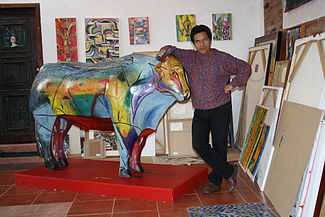Miguel Betancourt
| Miguel Betancourt | |
|---|---|
|
Miguel Betancourt | |
| Born |
January 5, 1958 Quito, Ecuador |
| Nationality | Ecuadorian |
| Education |
Milwaukee Art Center,[1] Slade School of Fine Art University College London,[2] Pontificia Universidad Católica del Ecuador |
| Known for | Contemporary Art |
| Website | |
|
www | |
Miguel Betancourt (born January 5, 1958) is an Ecuadorian contemporary artist living in Quito, Ecuador. He was formed as an artist in Ecuador, the United States, and the United Kingdom. His paintings are a fusion of local cultural motives and colors, and Western artistic influence.
Life
Born in Quito, Ecuador in 1958, Betancourt grew up in the outskirts of the city (Cumbayá). His talent drew attention early in his teenager years, and he was encouraged to attend art classes in Quito. Prominent Ecuadorian artist, Oswaldo Moreno, became his tutor, friend and artistic guidance. His artistic talent earned him a scholarship to study at the Milwaukee Art Center, United States, for a year. Upon his return to Ecuador, he enrolled in university to study Pedagogy and Literature at the Pontificia Universidad Católica del Ecuador.
In 1988, he was invited by the Department of State of the USA to a Cultural Tour. In the same year, the British Council awarded him a scholarship to study a postgraduate art degree at the Slade School of Fine Art at the University College London. Subsequently, he strengthened his presence in Europe with a traveling exhibition through England, the Netherlands and Austria. In 1993, he was selected to represent his country at the XLV. Venice Biennale, Italy and then received the Pollock-Krasner Award conferred by the Pollock-Krasner Foundation in New York City, USA. Meanwhile, his art was exhibited in museums and exhibitions, and found part in private collections in Europe and Latin America, including the art collections of the United Nations offices in Vienna and in Geneva (specifically in UNAIDS). In 2000, the University of Western Sydney invited Betancourt to lecture on Ecuadorian art and exhibit his artwork at the Canberra Museum and Gallery. Between 2001 and 2003, his paintings went on itinerant shows through Central America. Highlights in the recent past include participation in Visual Trends in Ecuador´s Contemporary Art organized by the Corporación Andina de Fomento in Caracas, Venezuela (2004); participation as Invitee of Honor to the V. International Art Biennial SIART in La Paz, Bolivia (2007), and in The Night of the Museums in Buenos Aires, Argentina (2009).[3] He was appointed to be the Ecuador coordinator of Luciano Benetton's (Benetton family) Ojo Latino Project (Milan 2008) – a book publication of Latin American contemporary art selected by Benetton. Betancourt continues to be involved in various projects and exhibitions in Ecuador and internationally.
Art
Miguel Betancourt grew up in a rural environment, in one of the outskirt valleys of Quito. His earliest artistic manifestations were inspired by the surrounding landscapes. Colorful and abundant vegetation, trees, the Andean mountains and clear blue skies turned into his constant motifs throughout his artistic career.[4] In his beginnings, Betancourt explored with watercolors[5] and became interested in pre-Columbian symbols, notably the Quipus – the numerical system designed by the Incas – and the cityscape of Quito (see Gallo de la Catedral).
During his one-year experience in England and travels through Europe, he was attracted to Gothic cathedrals, to their elongated arches and the contrasting light of stained glasses, which left a long lasting impression and a strong appeal for architecture. Likewise, his live exposure to Western art, including paintings by Van Gogh, Miró, Picasso, F. Bacon, and its artistic diversity encouraged him to move towards greater dimensions and mixed media, including oil painting and acrylic.
In the early 1990, he returned to Ecuador to combine Ecuadorian and European motifs, through a mix of tropical vegetation and gothic European architecture in large canvases with mixed media. In his exhibition Selva Ojival in 1992-93 (see Ojivas de la Selva) the tree, one of the central motifs of this series, integrates the culture constructions of the Gothic.[6] His interest in more diverse architecture flourished further – he took inspiration from pre-Columbian temples, colonial churches and neighborhoods, and foreign cities that he visited on cultural tours – among them Jerusalem. In the 2000s, Betancourt adopted new media, techniques and styles; whilst continuing to work on paper and canvas, he adopted a novel and well appreciated support, the cànamo (hemp). On hemp, he impregnated abstract and architectural trees – creating a fusion of trees, plants, geometrical shapes and city views – often accompanied by abundant texture, attained through the incorporation of various materials such as wood, branches, and volcanic ash (see Árbol de letras).
In 2003-2004, he introduced a fresh artistic style, based on a combination of collage, blue drawing and dripping that differed from his previous art work. For his new artistic proposal in 2003, made up of a series of blue drawings over kraft paper, he employed wooden branches to draw human bodies and faces (see Naipe). In the following years, Betancourt pursued his interest on human faces, recreating strong, colorful portraits through a fusion of cubist and expressionist styles (see Flora y Fauna en Cabeza Femenina). In 2008, he, among other Ecuadorian artists, participated in the Ispirato Corpo project in the Cuenca Biennial of Ecuador,[7] where he impregnated a mix of abstract vegetation forms, drawing and dripping on haute couture dresses.[8] In the same year, he participated in an urban art project called Toros de Colores (Colored Bulls), in which several artists painted on bulls made out of glass fiber that were subsequently exhibited in public spaces throughout the city of Quito. In 2011, he was invited again to participate in the project Quito Jardin de Quindes (Quito Garden of Hummingbirds),[9] where a group of prominent Ecuadorian artists painted on large scale ceramic hummingbirds to honour Quito's cultural symbol [the hummingbird].[10] In November 2011, he presented an individual retrospective Colores y Texturas (Colors and Textures). This large exhibition, shown in the Casa de la Cultura Ecuatoriana, compiled approximately 100 paintings from the past 25 years of his artistic career.[11] One of Betancourt's recent projects was a group exhibition of four Ecuadorian artists named Aequatoria, Plus Ultra Conceptus in the Instituto Cervantes in Rome.[12]
Main Exhibitions
- (1993), XLV. Venice Biennale – Venice, Italy.
- (2000), "Legados de Magma", Canberra Museum and Gallery, Australia.
- (2001–2003), A Touring exhibition throughout Central America.
- (2004), "Visual Trends in Ecuador´s Contemporary Art", Corporación Andina de Fomento – Caracas, Venezuela.
- (2007), Invitee of Honor to the V. International Art Biennial SIART – La Paz, Bolivia.
- (2009), "The Night of the Museums", An art event sponsored by the City Government of Buenos Aires, Argentina.
- (2011), "Betancourt: Colores y Texturas", Retrospective Exhibition, Casa de la Cultura Ecuatoriana[13] – Quito, Ecuador.
- (2012), "Aequatoria, Plus Ultra Conceptus", A group exhibition presented in the Instituto Cervantes – Rome, Italy.
Gallery
-
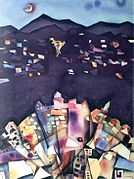
Gallo de la Catedral, watercolor / paper, 76x56cm, 1987
-
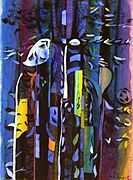
Ojivas de la Selva, acrylic / paper, 76x56cm, 1992
-
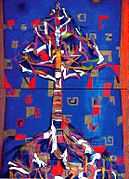
Árbol de letras, mixed / hemp canvas, 256x186cm, 2001
-
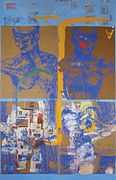
Naipe, mixed / canvas & cardboard, 320x200cm, 2006
-
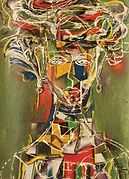
Flora y Fauna en Cabeza Femenina, oil / canvas, 110x45cm, 2009
Bibliography
- Michelena, X. and Querejeta, A. (1996) "Betancourt", Paradiso Editores, Quito (Ecuador).
- Flores, I. et al. (2001) "Nuevos Cien Artistas", Revista Mundo Diners, Quito (Ecuador).
- Rodríguez, M.A. (2011) "Betancourt: Colores y Texturas",[14] Casa de la Cultura Ecuatoriana, Quito (Ecuador).
- Rodríguez, M.A. (2011) "Palabra de Pintores - Artistas del Ecuador", Casa de la Cultura Ecuatoriana, Quito (Ecuador).
See also
References
- ↑ Art in Embassies, from the website of the U.S. Department of States.
- ↑ UCL Alunmi Newsletter, alumni newsletter of the University College London: March 2009.
- ↑ Article in the Américas Magazine, Blanco, A. (2010). "Expressions of Experience", Américas Magazine published by the Organization of American States, Vol. 62, Nr. 3, May/June 2010, Washington, D.C. (USA).
- ↑ Interview with the artist for the newspaper El Comercio, Redacción Cultura, El Comercio (2011). "Miguel Betancourt, artista ecuatoriano", El Comercio, November 2011, Quito (Ecuador).
- ↑ Article in the Safiqy Magazine, Rodríguez, M. A. (2011). "Miguel Betancourt, los ciclos de un maestro", Safiqy Magazine in section Eros, 5 October 2011, Quito (Ecuador).
- ↑ Article in Hernán Rodriguez Castelo Website, Texto de presentación de muestra pictórico, Rodriguez Castelo (2008). "Miguel Betancourt sigue ahondando en motivos y materiales", Quito (Ecuador).
- ↑ Main website of the Cuenca Biennial, Pedro Crespo Flandoli and Tomas Quintanilla (2012). Bienal Internacional de Pintura de Cuenca, Cuenca (Ecuador).
- ↑ Article about the Ispirato Corpo project on the website of the newspaper El Universo, Redacción Arte y cultura, El Universo (2011). "El arte y la moda siguen evolucionando", El Universo, March 2011, Quito (Ecuador).
- ↑ Video on the Quito Jardin de Quindes Project, Victoria Oliva (2011). Exposición de Arte Urbano en la Calle, Quito Jardín de Quindes (Ecuador).
- ↑ Article about the Quito Jardin de Quindes project in El Telégrafo, Arte Urbano, El Telégrafo (01/15/2012). "Estos quindes prefieren posar que volar", El Telégrafo, Quito (Ecuador).
- ↑ Article on Portal of Ecuadorian Art and Culture, J. Pazos Barrera, (2009). "Miguel Betancourt y el Bosque Incesante", Website of Arte y Cultura del Ecuador, July 2009, Quito (Ecuador).
- ↑ Catalogue: Betancourt – Aequatoria, Plus Ultra Conceptus, personal website of the artist.
- ↑ Casa de la Cultura, Casa de la Cultura Ecuatoriana "Benjamín Carrión", Quito (Ecuador).
- ↑ Catalogue: Betancourt – Colores y Textures, personal website of the artist.
